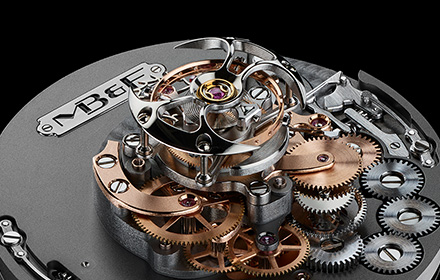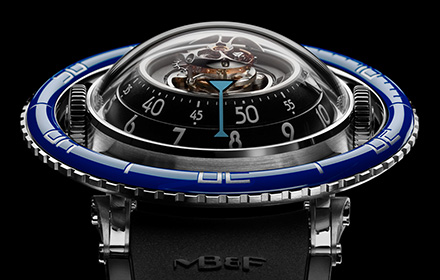After pushing the boundaries of horological exploration by blasting into outer space (HM2, HM3, HM6), launching into the sky (HM4, HM9), and powering down the road and around the track (HM5, HMX, HM8), MB&F plunges into the water with Horological Machine No.7, aka HM7 Aquapod.
The organic jellyfish-inspired design of HM7 Aquapod is counter-balanced by the very mechanical horology within: a central 60-second flying tourbillon tops the concentric vertical movement architecture, with indications radiating out from the centre like ripples in a pond. Like many jellyfish, HM7 glows in the dark: on the hour and minute numerals, around the inside of the movement and along the tentacle-like winding rotor.
The 303-component (391 for the Platinum Red edition), 72-hour power reserve HM7 Engine was developed in-house by MB&F. Spherically three-dimensional, all its mechanisms – from the winding rotor at the bottom, to the flying tourbillon on top – rotate concentrically around the centre. The curves of the high-domed sapphire crystal are mirrored in the shape of the time display rings.
more pictures in press section
The flying tourbillon at the very top of the movement is positioned for maximum appreciation by day, while three panels of AGT Ultra (Ambient Glow Technology) lume around the inside of the movement illuminate the tourbillon by night.

The winding rotor’s tentacles are machined from a solid block of titanium with a platinum sector underneath. Their curved, three-dimensional nature alternates between polished and satin-finished sections. Super-LumiNova segments along the rotor make it glow in the dark.

While HM7 is not a dive watch, it is a timepiece comfortably at home in the water – so MB&F added the one element that all serious aquatic watches possess: a unidirectional rotating bezel. But unlike every other dive watch, Aquapod's bezel isn't attached to the case, but floats apart.
For more live pics, wristshots and other cool images, check out our Instagram account.

The idea for an aquatic watch originated from Maximilian Büsser’s memories of family beach holidays, which included an encounter with a jellyfish. While the encounter may have been minor, the seed it planted in Büsser's brain for a three-dimensional timepiece powered by tentacles was anything but.
HM7 began its gestation as a horological jellyfish, and the architecture of its Engine is appropriately biomorphic. Where a jellyfish generates power from food caught in its tentacles, HM7 generates power from its tentacle-like automatic winding rotor.
Where jellyfish have a radially symmetric ring of neurons for a brain, Aquapod has radially symmetric rings displaying hours and minutes. Where jellyfish have a hood or bell on top, HM7 has an imposing flying tourbillon regulating the power generated by the rotor.
And, like many jellyfish, HM7 glows in the dark. It glows on the numerals, markers and along the segments on the winding rotor but also around the inside of the movement.






THE LATEST FROM
Instagram
Visit our pagestay
tuned
Subscribe to our newsletter